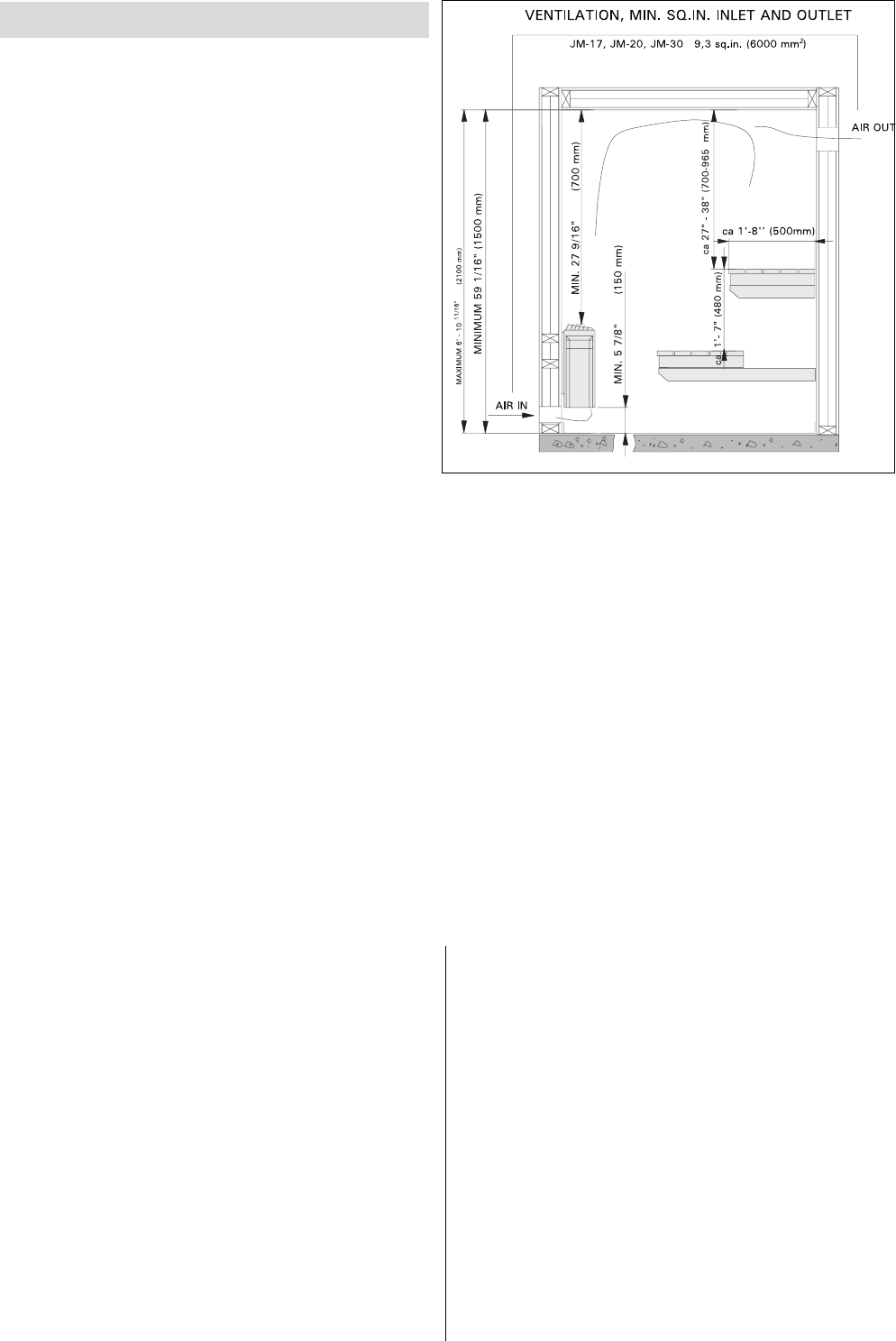
6
2. THE SAUNA ROOM
2.1. Insulation and Wall Materials of the
Sauna Room
In an electrically heated sauna, all the massive wall
surfaces which store plenty of heat (such as bricks,
glass blocks, plaster etc.), must be sufficiently
insulated in order to keep the heater output at a
reasonably low level.
A wall and ceiling construction can be considered
to have efficient thermal insulation if:
• the thickness of carefully fitted insulating
wool inside the house is 4" (100 mm) minimum
2" (50 mm).
• the moisture protection consists of e.g.
aluminium paper with tightly taped edges. The
paper must be fitted so that the glossy side is
towards the inside of the sauna.
• there is a 3/8" (10 mm) vent gap between the
moisture protection and panel boards
(recommendation).
• the inside is covered by 1/2" – 5/8" (12–16 mm)
thick panelling.
• there is a vent gap of a few millimetres at the
top of the wall covering at the edge of the
ceiling panelling.
When aiming at a reasonable heater output, it may
be advisable to lower the ceiling of the sauna
(normally 6'–10
11/16
" (2100 mm), minimum height 59
1/16" (1500 mm). As a result, the volume of the
sauna is decreased, and a smaller heater output may
be sufficient. The ceiling can be lowered so that the
ceiling joists are fixed at a suitable height. The spaces
between the joists are insulated (minimum insulation
4" (100 mm) and surfaced as described above.
Because heat goes upwards, a maximum distance
of 38" (970 mm) is recommended between the
bench and ceiling.
NOTE! Consult fire-extinguishing authorities to find
out which part of the fireproof wall may be insulated.
NOTE! The protection of the walls or ceiling with
heat protection, such as mineral board fitted directly
on the wall or ceiling, may cause the temperature of
the wall and ceiling materials to rise dangerously high.
2.1.1. Room construction – general information
FRAMING 2" x 4" Dry Douglas Fir, 16" o.c.
CEILING HEIGHT No higher than 7' 0".
INSULATION R11 Fiberglas with foil back in
walls and ceiling, foil facing
into room.
DRYWALL See local codes. Is not
required in most residences.
See local codes for
commercial. If drywall is used,
apply 1" x 2" nailers so that
wall and ceiling boards can be
attached to solid wood.
PANELING Use kiln-dried, clear,T&G
softwood such as California
Redwood, Western Red Cedar,
Alaska yellow Cedar, with
moisture content not exceeding
11%.
BENCHES Use matching wood of vertical
grain with 2"x 2" tops – 1/2"
spacing - and 2"x 4" facing,
fastening from bottom to prevent
burning of bathers.
HEATER
GUARDRAIL Use matching softwood
of1"x2"or2"x2".
DOOR Must open out and should not
have a lock. Size – 2' 0"x 6'8" with
fir rails and double sealed,
tempered glass.
ROOM LIGHT Should be a vapor proof, wall-
mounted type, with rough-in box
mounted flush with inside paneling.
It should mount 6" (150 mm) from
ceiling, not directly over the Sauna
heater, and not over upper
benches; light bulb should not
exceed 75 watts.
Note! Receptacles OR PLUGS are not allowed in a
Sauna room. If a speaker is installed in a Sauna room,
it should not be installed higher than 3' from floor,
away from the Sauna heater (consult manufacturer
for ratings).
2.2. Sauna Room Floor
Due to a large variation in temperature, the sauna
rocks disintegrate in use.
Small pieces of rock are washed down on the
sauna room floor along with the water thrown on the
rocks. Hot pieces of rock may damage plastic floor
coverings installed underneath and near the heater.
A light-cocoured joint grout, used for a tiled floor,
may absorb impurities from the rocks and water (e.g
iron content).
To prevent aesthetic damage (due to the reasons
presented above) only dark joint grouts and floor
coverings made of rock materials should be used
underneat and near the heater.
Figure 4. Sauna room














